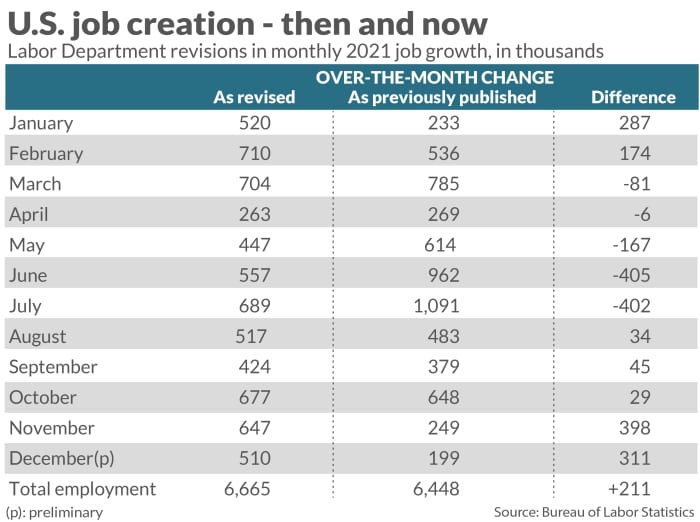This post was originally published on this site
The surprisingly bullish U.S. jobs report in January tells us two things. The labor market is not as feeble as it looked. And it’s all but impossible to figure out how many jobs the economy is adding each month in the middle of a pandemic.
The U.S. added a robust 467,000 new jobs in January, the government said Friday, triple the Wall Street
DJIA,
forecast. Hiring gains in the final two months of 2021 were also much stronger than originally reported.
The increase in employment in December was bumped all the way up to 510,000 from 199,000. And November’s gain was boosted to 647,000 from 249,000.
In short, the U.S. economy created 1.16 million new jobs at the end of last year — not a lackluster 498,000.
The revised employment figures “paint a notably different picture of the labor market,’ said chief economist Gus Faucher of PNC Financial Services.
Whoa. What happened? Start with the government’s annual do-over.
At the end of each year, the Bureau of Labor Statistics updates the jobs report after examining new Census data and tax records of individuals and businesses. The process results in more accurate employment figures.
Presto. Hiring in December and November was much better than it first appeared.
Yet even though the increase in hiring at the end of 2021 looks great, the annual revisions did not actually show much change in employment growth last year. Job gains, it turns out, were not quite as impressive in the middle of the year.
Take July and June. The increase in new jobs was 807,000 smaller than previously reported. (See the accompanying chart.)

Uncredited
“The crazy month-to-month swings in job growth in 2021 look much less volatile, although the overall trend is similar,” said chief economist Bill Adams of Comerica Bank.
The atypically large government revisions, meanwhile, underscore just how hard it is capture the true state of the labor market amid the worst pandemic in a century. All the disruptions to life and work have clouded the government’s ability to produce reliable numbers month to month.
The revisions reflect “how much more difficult it is to measure the economy accurately during a pandemic than in normal times,” Adams said.
What to take away from the January report then?
Economists say companies are hiring at a steady pace and more and more people are going back to work. That’s good news for the economy and shows the recovery is quite sturdy.
“The fact that omicron didn’t knock the jobs market backward last month as many had expected speaks to an economy that may not have lost as much momentum as feared in recent months,” said Jim Baird, chief investment officer at Plante Moran Financial Advisors.
Yet the U.S. still faces a major labor shortage that could restrain the recovery in the months ahead. Companies have nearly 11 million open jobs — twice as many per each unemployed individual.
As one business executive told ISM, “Labor shortages are causing issues. We could do much more business if we had more people.”


